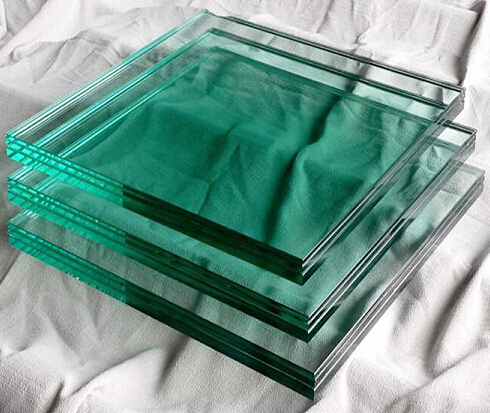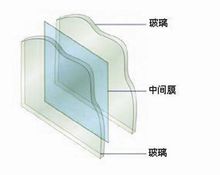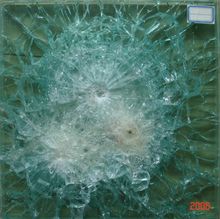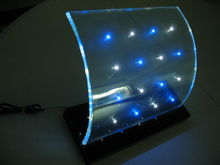
Laminated glass is a composite glass product consisting of two or more pieces of glass with one or more layers of organic polymer intermediate film sandwiched between them. After special high-temperature preloading (or vacuum pumping) and high-temperature high-pressure processing, the glass and intermediate film are permanently bonded together.
The commonly used interlayer films for laminated glass include PVB, SGP, EVA, PU, etc.
In addition, there are some special types such as colored interlayer laminated glass, SGX printed interlayer laminated glass, XIR LOW-E interlayer laminated glass, etc. Decorative and functional laminated glass such as embedded decorative components (metal mesh, metal plate, etc.) laminated glass, embedded PET material laminated glass, etc.
Main types
According to the different melting points of the intermediate film, it can be divided into: low-temperature laminated glass, high-temperature laminated glass, and insulating glass;
According to the different materials sandwiched in the middle, it can be divided into many types such as paper, cloth, plant, wire, silk, metal wire, etc;
According to the different bonding methods between interlayers, they can be divided into: mixed laminated glass, dry laminated glass, and hollow laminated glass;
According to the different layers of the interlayer, it can be divided into general laminated glass and bulletproof glass.
Material characteristics
Even if the glass breaks, the fragments will stick to the film, and the surface of the broken glass will still remain clean and smooth. This effectively prevents the occurrence of debris stabbing and penetration falling incidents, ensuring personal safety.

Mezzanine display
In Europe and America, most building glass uses laminated glass, not only to avoid injury accidents, but also because laminated glass has excellent seismic invasion resistance. The intermediate film can withstand continuous attacks from weapons such as hammers and machetes, and can also resist bullet penetration for a considerable period of time, making its level of safety precautions extremely high.
The glass is safe to break and may shatter under the impact of a heavy ball, but the entire glass still maintains a cohesive interlayer, with fragments and sharp small pieces still sticking to the intermediate film. When this type of glass breaks, the fragments will not disperse and are often used in vehicles such as cars.
Tempered glass requires a significant impact force to break, and once broken, the entire piece of glass bursts into countless fine particles, leaving only a small amount of broken glass in the frame.
Ordinary glass shatters upon impact, typically resulting in many long, sharp edged fragments.
When the laminated glass breaks, the mirror shaped fragments surround the opening, and there are many glass fragments around the penetration point. The length of the broken metal wire varies.
Safety glass
Definition
Refers to laminated glass, tempered glass, and insulated glass processed from them that meet the standards. Among them, laminated glass and insulating glass made of laminated glass have better comprehensive performance.
Classification
Generally, tempered glass for civilian use is made by heat treating ordinary glass to increase its strength by 3-5 times. It can withstand external impacts or temperature changes of a certain amount of energy without breaking. Even if it breaks, the whole piece of glass will be broken into small particles with a honeycomb like obtuse angle, which is not easy to harm people and thus has a certain level of safety. Tempered glass cannot be cut, it needs to be cut to the correct size before tempering, and it has the characteristic of "self explosion". According to different purposes, tempered glass can be divided into various types such as fully tempered glass, semi tempered glass, area tempered glass, flat tempered glass, curved tempered glass, etc.
Laminated glass, as a type of safety glass, will not produce sharp fragments that can injure people after being shattered by impact due to the bonding effect of the PVB film sandwiched between its two ordinary glass pieces. At the same time, the sound insulation and sunlight control properties of its PVB intermediate film make it a new type of building material with energy-saving and environmental protection functions: using laminated glass can not only isolate the 1000 Hz to 2000 Hz coincidence noise that can penetrate ordinary glass, but also block more than 99% of ultraviolet rays and absorb heat in the infrared spectrum. As a laminated glass that meets the performance requirements of new building materials, it is bound to play a huge role in the use of safety glass.
Application advantages

Even after being broken, it still won't fall off
The sound insulation effect of modern living rooms has become one of the important factors for people to measure the quality of housing.
Did you use Saflex? The laminated glass with PVB interlayer film can block sound waves and maintain a quiet and comfortable office environment. Its unique UV filtering function not only protects people's skin health, but also helps valuable furniture, displays, and other items in the home escape the fate of fading. It can also reduce the transmission of sunlight and lower cooling energy consumption.
The many advantages of laminated glass can also have unexpected good effects when used in home decoration.
Many family doors, including kitchen doors, are made of frosted glass material. When cooking, the kitchen fumes are prone to accumulate on top. If laminated glass is used instead, there will be no such trouble. Similarly, large glass partitions in the home can be a safety hazard for naturally active children. If laminated glass is used, parents can rest assured. Even if the glass breaks, fragments and sharp small pieces still stick to the intermediate film.
Production process

Curved LED glass display
LED glass, also known as photoelectric glass, PowerGlass, It is a perfect combination product of LED light source and glass, which breaks through the traditional concept of building decoration materials. Patterns can be pre designed inside the glass, and later controllable changes can be achieved through DMX fully digital intelligent technology, allowing for free control of the brightness and variation of LED light sources. Internally, fully transparent wires are used, which is different from ordinary metal wires, and no wiring can be seen on the glass surface; After special processing in the later stage, both technical and safety requirements have met the relevant certification standards.
Safety standards
National standard GB9962, European standard CE (including EN standard) ANSI、...
Compliance standards for glass materials:
① Float glass: GB11614;
② Embossed glass: JC/T511;
③ Wire mesh glass, wire mesh glass: JC433;
④ Tempered glass: GB/T9963;
⑤ Heat absorbing glass: JC536;
⑥ Half tempered glass: GB17841;
⑦ Class III laminated glass does not use laminated glass or tempered glass.
Key points for purchasing
Check the logo and certificate
Since the implementation of safety glass product certification in 2003, most of the building laminated glass production enterprises in China have passed product certification. Enterprises must screen print or paste the 3C mark on the product body they sell, or add the 3C mark on its smallest outer packaging and accompanying documents (such as certificates of conformity). When selecting a product, the first thing to check is whether there is a 3C mark, and based on the company information, factory number, or product certification certificate, check whether the purchased product is within the scope of the company's mandatory certification and whether the certification certificate is valid through the internet.
Check the appearance and quality
Check the appearance quality of the product, the laminated glass should not have cracks or delamination; The length or width of the edge should not exceed the thickness of the glass; Scratches and abrasions should not affect use; The defects such as bubbles, impurities, or other observable opaque substances in the intermediate layer should not exceed the requirements of GB/T15763.3 standard.
During use, external impact should be avoided as much as possible, especially for tempered laminated glass. When cleaning glass, be careful not to scratch or scrape the surface of the glass, so as not to affect its optical performance, safety performance, and aesthetics. When installing laminated glass, neutral adhesive should be used and contact with acidic adhesive is strictly prohibited.
Installation instructions
The installation of laminated glass is the same as that of ordinary glass.




